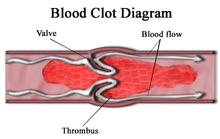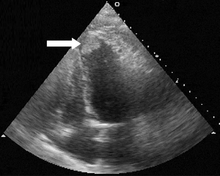Thrombus
Thrombus (plural thrombi; from ancient Greek θρόμβος thrómbos, German 'lump', 'plug'; coagulum) is the medical term for a blood clot in a blood vessel or in the heart. In contrast, the term coagulum is used for the extravascular blood clot.
Thrombi can form in both the venous and arterial parts of the bloodstream. A thrombus can block the vessel at its point of origin, or it can detach, be carried away by the bloodstream and cause blockages elsewhere, leading to a loss of blood supply to organs there. In this case, one speaks of an embolism or thromboembolism; the blood clot is then also called an embolus.
The clinical pictures triggered by thrombi include infarction, ischemic stroke, thrombosis or, as a consequence, pulmonary embolism.
Thrombi form, for example, after vascular injuries in order to close the injured area in the vessel from the inside and prevent major blood loss. In rarer cases, thrombi can also form spontaneously and without prior injury or other external influences, e.g. as a result of disorders of blood coagulation (haemostasis) or severely slowed blood flow velocity, due to coagulation as a result of an increased erythrocyte content.
In many cases, thrombi are dissolved by the healthy body itself without leading to the above-mentioned clinical pictures.
![]()
This article or subsequent section is not sufficiently supported by evidence (e.g., anecdotal evidence). Information without sufficient evidence may be removed in the near future. Please help Wikipedia by researching the information and adding good supporting evidence.
During autopsy, the pathologist must distinguish thrombi formed in vivo from a cadaveric clot. The latter can be easily extracted from the affected vessel, as it is not connected to the vessel wall.

Thrombi removed from the coronary arteries

Schematic representation
Types thrombi
By composition
- White thrombus (deposition thrombus): fibrin-rich thrombus
- Red thrombus (clotting thrombus): blood-rich thrombus
- Platelet thrombus: Thrombus consisting predominantly of platelets.
- Fibrin thrombus: Thrombus consisting only of fibrin.
- Phlebolith: also vein stone, a calcified vein thrombus in calcinosis dystrophica
According to place of origin
- Arterial thrombus: mostly wall thrombus formed predominantly by platelets and fibrin.
- Venous thrombus: red thrombus often formed in the area of the valves due to stasis
- Atrial thrombus: atrial fibrillation can lead to thrombus formation in the atrium (especially in the heart ear).

Ultrasound image of a thrombus (arrow) of the left ventricle
Inhibitors of thrombus formation
- Antiplatelet drugs such as acetylsalicylic acid (ASA; only for arterial thrombi) or clopidogrel
- Heparin
- 4-hydroxycoumarins, e.g. phenprocoumon
- Thrombin antagonists
- Direct oral anticoagulants (DOAKs or DOAKs)
Search within the encyclopedia